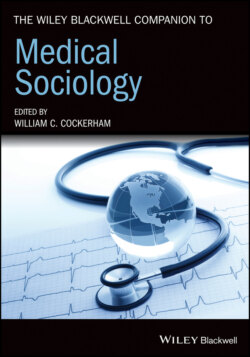Читать книгу The Wiley Blackwell Companion to Medical Sociology - Группа авторов - Страница 87
Body Work
ОглавлениеAs Twigg and her colleagues (2011) argued book on the body in health and social care, the material body is essential to any adequate analysis of health care in practice.
Body work is work that focuses directly on the bodies of others: assessing, diagnosing, handling, treating, manipulating, and monitoring bodies, that thus become the object of the worker’s labour. It is a component part of a wide range of occupations. It is a central part of healthcare, through the work of doctors, nurses, dentists, hygienists, paramedics and physiotherapists. (Twigg et al. 2011: 171)
Medicine, health, care, and the body are inextricably interlinked. Analyses of, or policies on, health and social care which overlook the messy realities of the body will invariably be wanting. The rationalistic approach which has tended to dominate policy debates, “presents a bleached out, abstract, dry account that takes little cognizance of the messy, swampy, emotional world of the body and its feelings” and Twigg suggests that a focus on the body “promises to bring the world of policy into much closer and direct engagement with its central subject” (Twigg 2006: 173).
In what ways can theorizations on the body and embodiment help us to make sense of health care in practice? There are some excellent qualitative studies of health care work within formal settings that can help us answer this question. Julia Lawton’s (1998) study of care within a hospice is an excellent example. Her ethnographic study sets out to understand why it is that some patients remain within the hospice to die whilst others are more likely to be discharged and sent home to die. To address this health policy puzzle, Lawton argues we need to focus on the body of the dying person. She found that those patients cared for within the hospice were those whose bodies became unbounded. By this she means that the diseases they were suffering from involved a particular type of bodily deterioration and disintegration requiring very specific forms of symptom control, the most common examples being:
incontinence of urine and faeces, uncontrolled vomiting (including faecal vomit), fungating tumours (the rotting away of a tumour site on the surface of the skin) and weeping limbs which resulted from the development of gross oedema in the patient’s legs or arms. (Lawton 1998: 128)
It is these forms of bodily (dys)functions that people living in Western society cannot tolerate rather than the process of dying itself. Indeed, in those cases where the boundedness of their bodies could be reinstated, patients would be discharged. To address the question of why unbounded bodies are unacceptable in Western society, Lawton draws upon much of the sociological theorizing outlined above – especially the work of Douglas and Elias. The unbounded body is perceived symbolically, according to Douglas, as a source of dirt – it is matter out of place. The increasingly “civilized” body, according to Elias, has become “individualized” and private, and the “natural” functions of the body are removed from public view.
The fact that natural or intimate bodily functions are problematic for health care practitioners is also been explored by Lawler (1991), who again draws upon the ideas developed by Elias and Douglas in her study of nursing care in an Australian hospital. Quintessentially, the work of nurses is about caring for bodies. This becomes a problem when nurses have to attend to those bodily functions (defecating, grooming, etc.) which in a “civilized” society have become taboo. Consequently, nurses have to learn how to negotiate social boundaries and create new contexts so that both the patient and the nurse can avoid feelings of shame and embarrassment. There is a further fascinating finding highlighted in Lawton’s study, and this relates to the link that we have discussed above between the notion of self and physical body. The two are meshed together. Lawton’s work demonstrates that even where there is a “competent” mind, the lack of bodily controls (Nettleton and Watson 1998: 14–17) affects a person’s capacity to continue with their life projects or their reflexive self. In fact, patients who had the least control over their bodily functions exhibited behavior which suggested a total loss of self and social identity once their bodies became severely and irreversibly unbounded. Take Lawton’s account of Deborah, for example:
When Deborah’s bodily deterioration escalated, I observed that she had suddenly become a lot more withdrawn. After she had been on the ward for a couple of days she started asking for the curtains to be drawn around her bed to give her more privacy. A day or so later she stopped talking altogether, unless it was really necessary (to ask for a commode, for example), even when her family and other visitors were present. Deborah spent the remaining ten days of her life either sleeping or staring blankly into space. She refused all food and drink … One of the hospice doctors concluded that “for all intents and purposes she [had] shut herself off in a frustrated and irreversible silence.” (Lawton 1998: 129)
We see how the bounded body is foundational to the representation and reproduction of a coherent self in the context of societies that extol individualism and where the independent, autonomous body is privileged.
